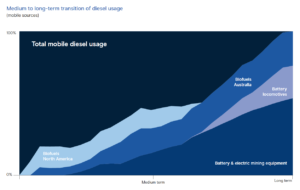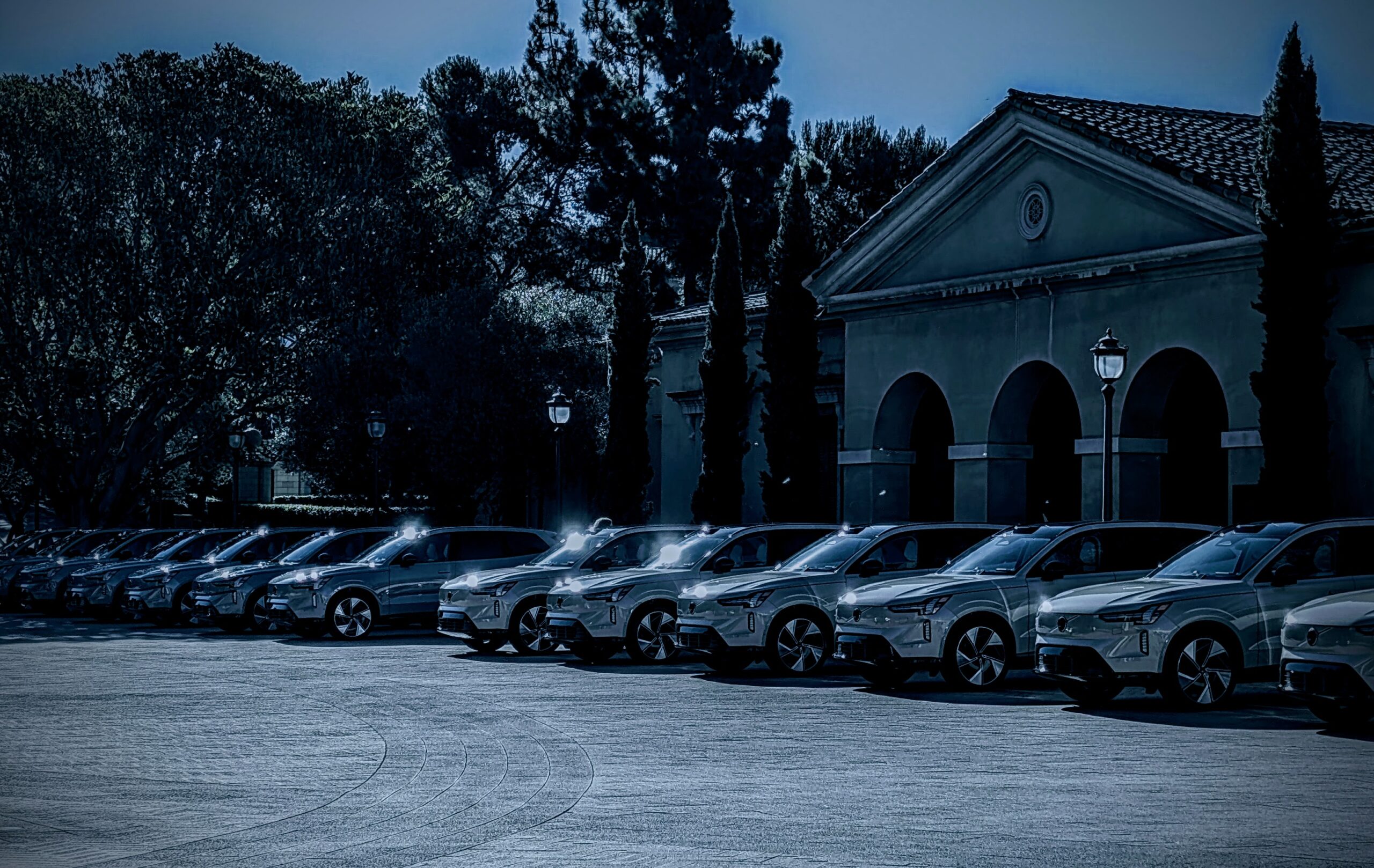While large fleets of battery electric trucks in mining remain the ultimate goal for the big mining houses, there is a recognition that major challenges remain in terms of charging strategy, the use of existing fleets plus just the readiness of the large battery electric equipment in energy density terms for full operational deployment, with the very first early models for testing purposes only set to arrive at mining customer sites this year.
In its just released Climate Change Report 2023, Rio Tinto CEO Jakob Stausholm states: “We continue to believe electrification is the most efficient and cost-effective way to eliminate our diesel emissions, but we are not expecting large-scale deployment of electric fleets to our operations before 2030. In the interim, we are investigating and deploying transitional, drop-in solutions, including renewable diesel.”
In May, Rio’s Boron operation in California became the world’s first open pit mine to successfully transition heavy machinery from fossil diesel, resulting in an annual abatement of 45,000t CO2. And in late 2023, the miner announced deployment of renewable diesel at nearly ten times this scale at its Kennecott Copper operation in Utah. Stausholm said replacing diesel fuel with renewable diesel at this site in 2024 will reduce emissions at Kennecott by an estimated 80% or up to 495,000t CO2 per year.
Rio Tinto’s broad summary of its expected mobile diesel usage transition

For Scope 1 and 2 emissions, Rio Tinto has committed to reaching net zero by 2050 and set ambitious interim targets relative to its 2018 equity emissions baseline: to reduce greenhouse gas (GHG) emissions by 15% by 2025 and by 50% by 2030. In the Pilbara, it says it remains committed to building 1 GW of renewable energy capacity. “However, due to the extended timeline for deployment of battery electric haulage solutions, we now estimate that 600MW to 700MW capacity is required by 2030.”
The miner’s Scope 1 and 2 emissions stood at 32.6 Mt CO2e in 2023. “This is 6% below our 2018 baseline of 34.5 Mt CO2e and slightly below our adjusted 2022 emissions of 32.7 Mt CO2e (adjusted for acquisitions). Abatement delivered by our projects in 2023 exceeded emissions growth from higher production giving a slight reduction in emissions on a like for like basis. Our 2023 emissions were slightly higher than our actual 2022 emissions total of 32.3 Mt CO2e due to the recent acquisitions of additional equity in OT and MRN.”
In action terms, in 2022, Rio Tinto established six abatement programs to focus on the decarbonisation challenges across its product groups: repowering Pacific Aluminium Operations, Alumina Processing, Aluminium Anodes, Renewable Energy, Minerals Processing, and Diesel Transition. Its pipeline of abatement projects is evolving as projects approach commercial and technical readiness.
From a mining equipment point of view, the program of most interest is Diesel Transition. Rio Tinto spent $1.6 billion on diesel in 2023 and consumed 1.6 billion litres of diesel at its major operations. Some $38 million was devoted to decarbonisation strategy spend in 2203.
Looking at this Diesel Transition program, Rio gave some good insights into the crux of the here and now challenges of a switch to BEVs: “Diesel is the primary energy source for Rio Tinto’s core mining operations, powering our operations globally and accounting for 12% of our total emissions in 2023. Our efforts in developing solutions to decarbonise our operations, which include the modelling of energy systems and solutions, reinforce the view that the long-term solution for transitioning our mining fleet and equipment from fossil fuels is electrification. However, to support meaningful emissions reductions in the mining industry, specialised electric vehicles – distinct from those used in the transportation and consumer sector – are essential.”
It adds: “These vehicles must be adaptable to changing mining plans and must deliver powerful performance to support intense work cycles. Most importantly, they will need to be safe, reliable and capable of supporting extended battery capacity and cycle life under harsh and perpetual operating conditions. A robust fleet is only part of the infrastructure required to support the large-scale transition to an electric mining fleet at our operations. Dynamic and flexible charging infrastructure is also required to support constantly evolving mine plans and equipment routes. It is likely charging stations cannot remain fixed in one location and may need to be complemented by mobile solutions. The charging network must also be underpinned by access to renewable energy sources and the related systems needed to operate these.” Partnerships are highlighted as being crucial to success: “Active partnerships are required to accelerate the development of battery-electric haul trucks and charging solutions, which we believe will be operationally available at scale after 2030, and will be critical to 2050 target.”
The report continues: “Although current technology does not yet deliver the energy density required in large mining vehicles, exciting progress, including the pace of electric vehicles roll-out and breakthroughs in mining fleet development, assures us that these challenges can be met through innovation and working together. We cannot pursue the electrification of our fleet in isolation. This is why we are committed to transitioning away from diesel through parallel investment in research and development projects, and the development of complementary approaches to reduce diesel-related emissions. These include increasing fuel efficiency and biofuels procurement.”
On 2030 targets, it says that biofuels are critical “to ensuring we meet our 2030 Scope 1 and 2 emissions targets and we are exploring short and medium-term commercial biofuel options to rapidly reduce our reliance on diesel.” It also says it is looking to develop and deploy partial abatement solutions with shorter execution timelines and existing technology. “We are prioritising projects that can contribute meaningfully to diesel reduction in line with our 2030 targets. These projects achieve partial abatement and include commercially available technology such as lower fuel-burn dig units and cable electric shovels, and shorter lead-time technology such as innovative trolleys.”
Trolley has a role in Rio Tinto’s roadmap too. It is looking to develop a viable trolley assist option for the existing haul fleet, to enable a substantial reduction in diesel use while on trolley. “We continue to assess this technology to identify suitable operations where it can be deployed, either standalone or as a precursor to wider fleet electrification. Limitations to deployment include retrofitting to existing operations and a dependence on the availability of renewable energies.”
On electrification, Rio Tinto has now completed a six-month test program of a Scania 20 t battery electric truck at its Channar operations in the Pilbara. It also continues involvement in CharIN and the ICMM’s Initiative for Cleaner Safer Vehicles to build on collaborative industry partnerships, to solve challenges related to inter-operability and large electric truck dynamic charging.
Carrying momentum into 2024, the miner as stated will transition its Kennecott Copper operations to renewable diesel. Plus it is set to commence battery electric haul truck trials in the Pilbara. It will also develop a deployment plan for partial abatement electrification options as well as consider options to develop an Australian biofuel supply chain.




